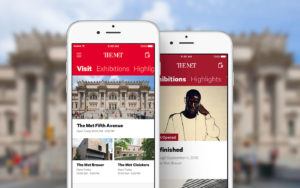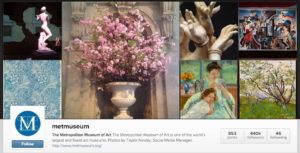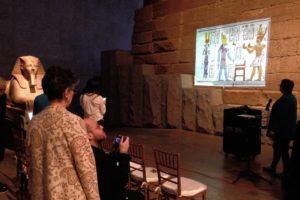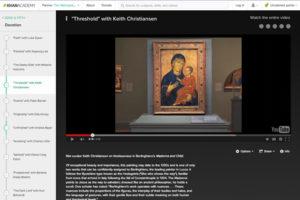Picasso or House of Cards? How the Met is Vying for Your Attention in a Digital World

Who wants to spend an afternoon at a museum when you can binge-watch the latest season of House of Cards on Netflix? The greatest challenge that the Metropolitan Museum of Art faces is to stay relevant in the digital world and compete for the attention of an increasingly distracted audience.
Companies are fighting for our attention and our eyeballs as we spend more time in the digital world. We are busy uploading pictures on Instagram, sending snaps on Snapchat and surfing posts on Facebook. The way we consume media, culture and content is rapidly changing and becoming more digital. Where does this leave museums like the Met, the original content curators before the tech media giants showed up[1]? The digital revolution has forced the Met to radically rethink how people should experience culture and art. As their former Chief Digital Officer Sree Sreenivasan puts it, “our competition is Netflix and Candy Crush,” not other museums[2]. The Met has the largest collection of art in the Western Hemisphere with over 2 million objects[3]. It is also the largest tourist attraction in New York with over 6.7 million visitors this past fiscal year[4]. The Met has plenty of content to share with its large audience but how it shares it will determine its success.
From Museum to Media Company: A Business Model Shift
The Met’s business model was rooted in providing a cultural experience for friends and families to enjoy curated art exhibits. Exhibits have been wide ranging from Max Beckman in New York to Native American Masterpieces[5]. Visitors entered the museum, walked around (sometimes with a tour guide), observed art and then left.
To stay relevant to customers, the Met has decided to embrace technology instead of fight it. It wants to fit in with social media and content creators like Snapchat and Facebook. In 2011, the Met began this digital reinvention[2]. It started by re-positioning its business model not as a museum but as a media company that delivers value to customers by creating, curating and distributing content. Digital would serve as an (1) origination channel to bring in new consumers into physical locations, (2) an engagement tool to enrich the in-person museum experience, and (3) a retention tool to increase engagement post-visit.
Selfies, Virtual Reality and Khan Academy: A New Type of Operating Model for the Digital Age
As part of its commitment to transform its business model into a media company, the Met made critical changes to its operating model:
- Leadership and HR: The Met hired Sree Sreenivasan as its Chief Digital Officer who quickly launched a 70-person digital media team and a 70-person tech hardware team, creating a tech media startup within the organization focused on the Met’s digital transformation[2][3].https://www.youtube.com/watch?v=nvr0kF2KbHg
- Digitization Effort: The Met began digitizing its object collection and made over 400,000 images publicly available.[3] The organization also built a high-powered app that makes it easier for visitors to explore the museum[6][7].

- Social Media and Digital Marketing: The days of not being able to use your phone to take pictures are over. The Met is very much “pro-selfie[2].” Photos are encouraged as the Met’s Facebook and Instagram presence continues to grow with over a million people on each platform[4]. The Met has also been sending out more targeted engagement emails (e.g. 55 billion emails were sent in 2015)[3].

- New Technology Adoption: A partnership is being explored with Oculus to develop virtual reality experiences for the museum[3]. The objective is to inspire greater interest and encourage people to visit the museum to learn more. New technologies are constantly being tested such as Blippar, an augmented reality smartphone app that animates a painting through an iPhone[2]. The museum also hosts a 3D Hackathon inviting artists and programmers to work on integrating 3D art and printing into its content[8].

- Digital Partnerships and Initiatives: A partnership was set up with Khan Academy to provide educational content on art[9]. The Met also created an experimental video initiative called the Artist Project in which 100 of the world’s most important artists discuss their favorite art in a TV-show format[10].

Opportunities, Challenges and Recommendations
The digital revolution gives the Met an incredible opportunity to engage more deeply with its audience. There are more and more ways to integrate technology to create more interactive and enriching experiences, while cultivating new audiences. The challenges are also many. There is constant competition from tech media companies in terms of monopolizing people’s time.
The Met needs to take the following steps to stay relevant:
- Continue to invest in immersive technologies such as VR and AR to enrich and re-imagine the museum experience both during the visit and at home[11].
- Create software that learns people’s interests to create a personalized digital and physical experience[12].
- Focus on fundraising so it can attract top-tiered developers who might otherwise work at tech media giants.
- Engage its growing international digital audience (the majority of its social media followers) by increasing partnerships with international museums[4].
The Met has its work cut out for it, but it’s headed in the right direction. Time to turn off Netflix and visit the Met!
(Word Count: 797)
Sources
- Amy Henderson, “Can Museums and Other Institutions Keep up With Digital Culture?” Smithsonian Magazine, March 7, 2015, http://www.smithsonianmag.com/smithsonian-institution/can-museums-and-other-institutions-keep-up-digital-culture-vulture-180949926/?no-ist, accessed November 2016.
- Les Shu, “Van Gogh vs. Candy Crush: How museums are fighting tech with tech to win your eyes,” http://www.digitaltrends.com/cool-tech/how-museums-are-using-technology/, accessed November 2016.
- Dillon Baker, “Museums, the Next Media Companies,” https://contently.com/strategist/2015/05/12/museums-the-next-media-companies/, accessed November 2016.
- The Metropolitan Museum of Art, “Annual Attendance,” http://www.metmuseum.org/press/news/2016/annual-attendance, accessed November 2016.
- The Metropolitan Museum of Art, “Current Exhibitions,” http://metmuseum.org/exhibitions/current-exhibitions, accessed November 2016.
- The Metropolitan Museum of Art, “The Future of Mapping and Wayfinding at the Met,” http://www.metmuseum.org/blogs/digital-underground/2016/future-of-mapping-and-wayfinding, accessed November 2016.
- The Metropolitan Museum of Art, “The Met App,” http://www.metmuseum.org/visit/met-app, accessed November 2016.
- The Metropolitan Museum of Art, “3D Scanning, Hacking and Printing in Art Museums, for the Masses,” http://www.metmuseum.org/blogs/digital-underground/posts/2013/3d-printing, accessed November 2016.
- The Metropolitan Museum of Art, “Khan Academy,” http://www.metmuseum.org/press/news/2014/khan-academy, accessed November 2016.
- The Metropolitan Museum of Art, “The Artist Project,” http://artistproject.metmuseum.org/, accessed November 2016.
- Center for the Future of Museums, “Trendswatch 2016,” https://aam-us.org/docs/default-source/center-for-the-future-of-museums/2016_trendswatch_final_hyperlinked.pdf?Status=Temp&sfvrsn=2, accessed November 2016.
- Steve Lohr, “Museums Morph Digitally: The Met and Other Museums Adapt to the Digital Age,” New York Times, October 23, 2014, http://www.nytimes.com/2014/10/26/arts/artsspecial/the-met-and-other-museums-adapt-to-the-digital-age.html, accessed November 2016.
Multimedia Sources
https://www.accuware.com/blog/location-awareness-in-museums/
http://www.wsj.com/articles/a-look-at-the-museum-of-the-future-1444940447
http://www.metmuseum.org/visit/met-app



Very insightful post, user123213! I agree with all your points, but I’m just worried that they focus too much on people that already care for and enjoy art. While I’m not saying that the House of Cards audience and the MET visitors don’t overlap, I believe that a ‘if you can’t beat them, join them’ approach might work better in order to source more visitors and engage a broader audience. In a way, they’re already doing that by being active in social media, instagramming, investing in VR, etc. But, what about partnering with media producers and distributors? How about getting MET content in Netflix or Hulu? Or partnering with the gaming industry to subtly appeal to a new audience?
I like this article a lot, and now want to check out the MET the next time I am up in NYC. My question though, is whether VR and AR could have a significant impact on the industry. As VR and AR develop, the physical location of the museum becomes somewhat irrelevant to the discovery and learning experience. Do you think the MET should be focusing on incorporating VR and AR into the physical museum or do you think they should be building the digital museum for VR and AR, i.e. with their knowledge and ability to develop content, that can be experienced anywhere? Also, how does the ability to use VR and AR shift the need the need to buy and curate physical exhibits, I wonder whether museums will move away from acquiring new works and artifacts, and what this will mean for the art industry as a whole.
The Met was smart in embracing social media (i.e. Instagram) and providing users with high-quality content. Seasonal art exhibits bring in new visitors to check out the new art and providing a sneak peek on social media is a way to draw crowd. I really like that the Met is experimenting with virtual reality. For some, this will be the first time engaging with virtual reality and mastery of the technology could be a signature of the Met. Art is experiential. Technology can further enhance the user’s experience by optimizing on sensory.
I love the Met (and art in general) and have given a lot of thought to these issues before, so thank you for your really well-researched post! I wonder if you saw the Charles James exhibit at the Met a couple of years ago (http://www.metmuseum.org/exhibitions/listings/2014/charles-james-beyond-fashion)? It was the most seamless integration of art and technology that I have seen in a museum. Yet, as Juan pointed out, a visitor cannot appreciate the technology until he/she is in the museum and it has been used specifically for niche exhibits. How do you think the Met can apply similar “modernization” techniques to its permanent collection which attracts more visitors? Does this somehow undermine the art? And if it undermines the art, does it drive away the art lovers – presumably your loyal and high quality customer base?
Thank you for writing! I’m curious to know what specifically the Met is working on with Oculus and other VR/AR companies. It’s not uncommon at this point for academics and museum curators alike, especially in more historical contexts, to leverage 3D models and technologies to recreate a certain time period (for example, the Karnak Project, which captures over 100 years’ analyses of the architectural styles of the Karnak Temple and acts as an interactive tool : http://news.harvard.edu/gazette/story/2013/03/dimensions-of-ancient-egypt/), and I wonder where more interactive AR/VR can play into 3D models that already exist. In this way, museums can become even more experiential outings…something similar to the curatorial decision to build in the objects into the space to recreate history, as the Louvre chose to do with the Mesopotamian human-headed winged bulls that were guardians and gatekeepers of certain cities (http://www.louvre.fr/en/oeuvre-notices/winged-human-headed-bull), but elevated with high tech to match millennials.
Great article. I completely agree that the Met should continue investing in using virtual reality. It would be great to be able to join friends from different locations (https://www3.oculus.com/en-us/blog/join-friends-in-vr-with-new-oculus-social-features/) to enjoy the museum together. Also, I think virtual reality is great for people that do not have the financial means to travel to the Met to enjoy the museum as well.
Does the Met use augmented reality to show films about the paintings during the visit?
Another thought, I wonder if the Met will have to restrict access to the digital media, so it is not available everywhere? Is it possible that the use of digital forms of the paintings will reduce the allure of coming to the Met? Nonetheless, it is great to see the museum adapting to the changing environment.